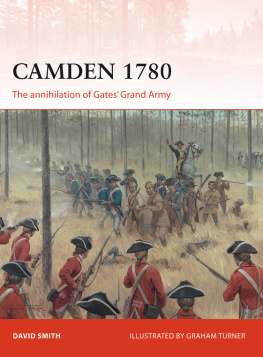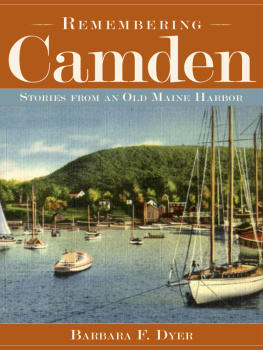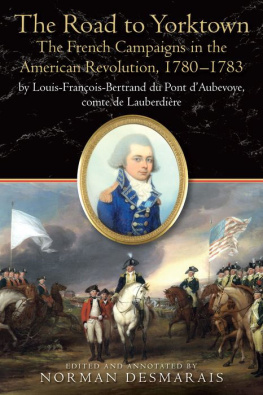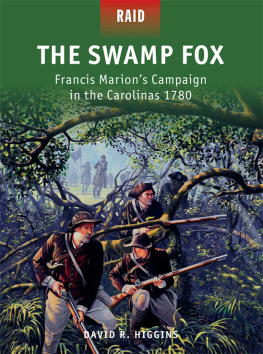Smith David - Camden 1780: the annihilation of Gates grand army
Here you can read online Smith David - Camden 1780: the annihilation of Gates grand army full text of the book (entire story) in english for free. Download pdf and epub, get meaning, cover and reviews about this ebook. City: Oxford;South Carolina;USA, year: 2016, publisher: Bloomsbury Publishing;Osprey, genre: History. Description of the work, (preface) as well as reviews are available. Best literature library LitArk.com created for fans of good reading and offers a wide selection of genres:
Romance novel
Science fiction
Adventure
Detective
Science
History
Home and family
Prose
Art
Politics
Computer
Non-fiction
Religion
Business
Children
Humor
Choose a favorite category and find really read worthwhile books. Enjoy immersion in the world of imagination, feel the emotions of the characters or learn something new for yourself, make an fascinating discovery.
- Book:Camden 1780: the annihilation of Gates grand army
- Author:
- Publisher:Bloomsbury Publishing;Osprey
- Genre:
- Year:2016
- City:Oxford;South Carolina;USA
- Rating:3 / 5
- Favourites:Add to favourites
- Your mark:
- 60
- 1
- 2
- 3
- 4
- 5
Camden 1780: the annihilation of Gates grand army: summary, description and annotation
We offer to read an annotation, description, summary or preface (depends on what the author of the book "Camden 1780: the annihilation of Gates grand army" wrote himself). If you haven't found the necessary information about the book — write in the comments, we will try to find it.
Camden 1780: the annihilation of Gates grand army — read online for free the complete book (whole text) full work
Below is the text of the book, divided by pages. System saving the place of the last page read, allows you to conveniently read the book "Camden 1780: the annihilation of Gates grand army" online for free, without having to search again every time where you left off. Put a bookmark, and you can go to the page where you finished reading at any time.
Font size:
Interval:
Bookmark:

First published in Great Britain in 2016 by Osprey Publishing,
PO Box 883, Oxford, OX1 9PL, UK
PO Box 3985, New York, NY 10185-3985, USA
E-mail:
This electronic edition published in 2016 by Bloomsbury Publishing Plc
Bloomsbury is a registered trademark of Bloomsbury Publishing Plc
2016 Osprey Publishing Ltd
OSPREY PUBLISHING IS PART OF BLOOMSBURY PUBLISHING PLC
All rights reserved
You may not copy, distribute, transmit, reproduce or otherwise make available this publication (or any part of it) in any form, or by any means (including without limitation electronic, digital, optical, mechanical, photocopying, printing, recording or otherwise), without the prior written permission of the publisher. Any person who does any unauthorised act in relation to this publication may be liable to criminal prosecution and civil claims for damages.
A CIP catalogue record for this book is available from the British Library.
ISBN: 978-1-4728-1285-8
PDF e-book ISBN: 978-1-4728-1286-5
e-Pub ISBN: 978-1-4728-1287-2
Editorial by Ilios Publishing Ltd, Oxford, UK (www.iliospublishing.com)
Maps by Bounford.com
3D birds-eye views by The Black Spot
Battlescene illustrations by Graham Turner
DEDICATION
This book is dedicated to my family Shirley, Harry and Josh.
ACKNOWLEDGEMENTS
I would like to thank various people for their help in the preparation of this book: Stuart Morgan for his excellent battlefield photography, David Reuwer for his expertise and guidance, Werner Willis and Don Troiani for their magnificent artwork, Chris Mlynarczyk of the 1st Delaware Regiment organization, Peter Harrington of the Anne S. K. Brown Military Collection, Mary Jo Fairchild from the Addlestone Library, Joanna Craig from the Historic Camden Revolutionary War Site, Tracie Logan from the United States Naval Academy Museum and Marcus Cowper of Ilios Publishing.
ARTISTS NOTE
Readers may care to note that the original paintings from which the color plates in this book were prepared are available for private sale. The Publishers retain all reproduction copyright whatsoever. All enquiries should be addressed to:
Graham Turner
PO Box 568
Aylesbury
Buckinghamshire
HP17 8ZX
UK
www.studio88.co.uk
The Publishers regret that they can enter into no correspondence upon this matter.
THE WOODLAND TRUST
Osprey Publishing are supporting the Woodland Trust, the UKs leading woodland conservation charity, by funding the dedication of trees.
CONTENTS


1.27 February 1776: battle of Moores Creek Bridge.
2.1 June21 July 1776: Clintons failed assault on Sullivans Island.
3.29 December 1778: British take Savannah.
4.5 May24 May 1779: first Tobacco Raid in Virginia.
5.16 September9 October 1779: British resist Franco-American siege and assault at Savannah.
ORIGINS OF THE CAMPAIGN
The campaign of 1780 had a long gestation period. The surrender of Lieutenant-General John Burgoyne at Saratoga, in October 1777, had fundamentally altered the landscape of the War of Independence, and it was upon this new landscape that British planning now had to operate. The loss of an entire army was a shocking blow and underlined the fact that the previous strategy had not worked.
A period of soul searching followed, as ministers and generals considered a new approach to the war. The major issue at hand was the increasing likelihood that the French would openly enter the war on the side of the colonists. French support had been important from the commencement of hostilities, but the arrival of French ground and (especially) sea forces in North America would drastically change the nature of the war. The American victory at Saratoga was just the sort of thing that might tempt the French to commit themselves openly to the rebel cause.
If, or more likely when, that happened, Britain would find itself painfully stretched. The rebels had proved resilient enough on their own during the first two campaigns of the war, but naval supremacy had remained one of the major cards in Britains hand. A French fleet in North American waters would be a frightening prospect and could threaten any of the British garrisons scattered through the colonies.
Of even more concern was the potential threat to British possessions in the West Indies. These were far more important, economically, than the North American colonies, and British forces, already spread thinly, would need to be relocated to protect Jamaica and a clutch of smaller islands in the Lesser Antilles: Barbuda, Antigua, St Kitts, Nevis, Montserrat, Barbados, St Vincent, Martinique, Guadeloupe and Dominica. Given the near certainty of French intervention in the war, it is remarkable that British planning initially took the hopeful view that it might not happen. Plans were initially made on the assumption that French forces would not arrive to complicate matters.

The loss of a substantial army when John Burgoyne surrendered at Saratoga impacted upon British planning for the rest of the war. (Library of Congress)
The first problem the British administration had to face was deciding who would be the commander-in-chief for the 1778 campaign, if the struggle was to be continued. The previous commander, Sir William Howe, had asked for and been granted permission to resign his post, having fallen out with the American Secretary, Lord George Germain.
Surprisingly, the top candidate to command the British army for the 1778 campaign was William Howe. This was at least partly because there just did not seem to be any attractive alternative. Howes second in command, Sir Henry Clinton, was not popular and his prickly manner promised nothing but trouble if he was elevated to overall command. Sir Guy Carleton had been so thoroughly disaffected by his removal from command of the Northern Army for the Saratoga campaign that he was unlikely even to enter into a correspondence with Germain, let alone accept a position from him.
The most energetic general in North America, the sort of man who might actually have waged the kind of campaign Germain had been dreaming of for nearly three years by this point, had just surrendered his army at Saratoga and many other potential candidates were unwilling to serve in America. Serious consideration was therefore given to attempting to persuade Howe to stay on, but eventually it was accepted that he had to go. With some reluctance, on 8 March 1778, Germain wrote to Clinton, informing him that he was to take over as commander-in-chief.
At the same time there was considerable debate over the form the next campaign should take. The opinions of Germains fellow secretaries of state, Lord Weymouth (Southern) and Lord Suffolk (Northern), were invited. Lord Sandwich at the admiralty and Sir Jeffery Amherst added military insight. This was to be a much more wide-ranging process than that employed for the first two campaigns of the war. There was no pre-ordained strategy to blind everyone to other options, as had been the case with operations along the Hudson in 1776 and 1777, and this was not to be a cosy committee of Germain and his generals. Despite the debate over whether or not to retain Howe as commander, his opinions were not invited, nor was Clinton involved at this stage.
Font size:
Interval:
Bookmark:
Similar books «Camden 1780: the annihilation of Gates grand army»
Look at similar books to Camden 1780: the annihilation of Gates grand army. We have selected literature similar in name and meaning in the hope of providing readers with more options to find new, interesting, not yet read works.
Discussion, reviews of the book Camden 1780: the annihilation of Gates grand army and just readers' own opinions. Leave your comments, write what you think about the work, its meaning or the main characters. Specify what exactly you liked and what you didn't like, and why you think so.








